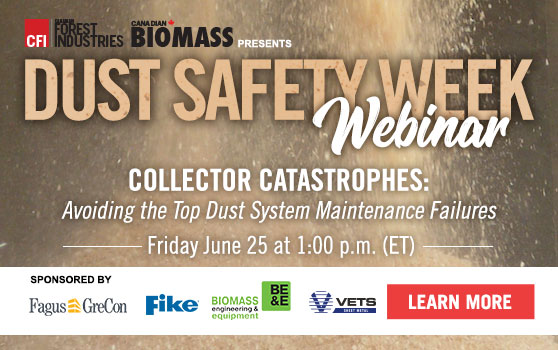
Features
Health and Safety
Sawmilling
‘Winning the battle’: webinar addresses top dust system maintenance failures
June 29, 2021 By Mike Jiggens

Several things can potentially go wrong within a fibre processing facility’s dust system, but proper maintenance and continuous monitoring can mitigate such failures. Left unchecked, various failures can lead to catastrophes such as explosions, fires, and serious injury (or death) to workers.
Francis Petit, P.Eng., an engineer with VETS Sheet Metal who specializes in dust abatement systems, shared his expertise in avoiding dust system failures in a webinar called, “Collector catastrophes: Avoiding the top dust system maintenance failures,” on June 25, which wrapped up Canadian Biomass and Canadian Forest Industries’ fifth annual Dust Safety Week.
“The better you know your system, the better you can maintain it without causing catastrophic failures,” Petit said at the beginning of his presentation, adding that the biggest failure is poor system design.
A poorly designed system will lead to increases in costs, maintenance and liability, he said.
Petit cited risks associated with five areas within a dust system: energizing and de-energizing, bad vibration, bearings and sheaves, plugs, and heat trace and water lines.
With regards to energizing and de-energizing, certain equipment in a dust collection system is energized. This means there is a risk of electrocution when performing maintenance on said energized equipment, he explained.
This risk and others can be mitigated by installing a properly designed dust collection system. In such a system, explosions can be prevented as pressure sensors will detect a rise in pressure and trigger chemical suppression, reducing the oxygen level in the vessel and preventing an explosion from reaching full maturity. Without such equipment, severe injury can occur in the event of an explosion.
Several things can also go wrong with fans, he said, noting that the bigger the fan, the more air flow it generates. If the fan is seeing a lot of dust, over time it can throw the fan wheel out of balance, causing failure through excessive vibration.
“Keep your fan clean and pay attention to vibration,” Petit cautioned.
A badly vibrating fan can create hairline fractures in the duct work. A fan that completely breaks down due to excessive vibration can injure or perhaps kill a nearby worker.
Bearings that are over- or under-greased can also result in failure, contributing to added downtime and halted production, Petit said. Bearings can contribute to an explosion if they’re not given proper care. Belts that are not properly aligned can wear quickly, causing the fan to fail and prematurely wear, leading to dust control issues.
Plugging is another critical risk that needs to be monitored in a dust collection system. To prevent plugging from occurring, duct hoods need to be properly placed in the correct location to capture dust. The objective is to keep dust suspended so that it doesn’t pile up and create plugs. Air flow velocity in the duct work should be kept at a permanent minimum, Petit said.
If plugging is a recurring problem, flex hoses should be checked with their length kept as short as possible to reduce the amount of static.
“If your filters are dirty and you’re trying to save some downtime, don’t replace half the filters,” he suggested. “Replace them all.”
A dirty filter will restrict the air flow and will cause a surge on the new filters, creating plugs.
Dirty filters lead to increased static pressure, Petit said, noting that when they are dirty, fans need to be sped up. When filters are clean, fan speed should be reduced. A constant air flow should be achieved. A fan’s rpm should be 1,200 with new filters and 1,410 with older filters.
Above all, it’s important that plugs be detected before they get out of hand, Petit said. The goal is to catch them before they reach the top of a filter. Otherwise, hours of maintenance will be required before the system can be put back on the grid.
In the end, it all comes back to the design of a dust system. If the collector is constantly plugging, there is a good chance it’s due to poor design, he said. Knowing and mapping a system will help to avoid plugs, which usually take upwards of a month to build up.
“If you can catch it at an early stage, you’re winning the battle,” Petit said.
Proper planning is also critical, especially given the extreme temperatures in some Canadian climates. Sprinkler lines that are allowed to freeze up will fail to do their job in the event of a spark, potentially leading to an explosion. But, proper planning will ensure a dust system will operate effectively for a long time, Petit said.
Good design from the start and proper maintenance are the keys to successful operations, Petit concluded. Correcting maintenance oversights will support a team’s safety as well as the facility and its operation.
Special thanks to VETS Sheet Metal, Fagus GreCon, Biomass Engineering & Equipment, and Fike, for sponsoring this webinar and Dust Safety Week 2021.
Print this page